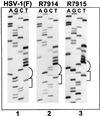A single amino acid substitution in the cyclin D binding domain of the infected cell protein no. 0 abrogates the neuroinvasiveness of herpes simplex virus without affecting its ability to replicate
- PMID: 10393969
- PMCID: PMC22209
- DOI: 10.1073/pnas.96.14.8184
A single amino acid substitution in the cyclin D binding domain of the infected cell protein no. 0 abrogates the neuroinvasiveness of herpes simplex virus without affecting its ability to replicate
Abstract
The infected cell protein no. 0 (ICP0) of herpes simplex virus 1 is a promiscuous transactivator shown to enhance the expression of genes introduced into cells by infection or transfection. The protein interacts with several viral and cellular proteins. Earlier studies have shown that ICP0 binds and stabilizes cyclin D3 but does interfere with the phosphorylation of retinoblastoma protein, its major function. Cyclin D3 plays a key role in the transition from G1 to S phase. To define the role of cyclin D3 in productive infection, the ICP0 binding site for cyclin D3 was mapped and mutagenized by substitution of aspartic acid codon 199 with the alanine codon. We report that the substitution precluded the interaction of this protein with cyclin D3 in the yeast two-hybrid system and the stabilization of cyclin D3 in infected cells. A recombinant virus carrying this mutation could not be differentiated from wild-type parent with respect to replication in dividing cells but yielded 10-fold less progeny from infected resting cells and serum-deprived or contact-inhibited human fibroblasts. In mice, the mutant was only slightly less pathogenic than the wild-type parent by intracerebral route but was significantly less neuroinvasive after peripheral inoculation. Replacement of the mutated amino acid with aspartic acid restored wild-type phenotype. Stabilization of cyclin D3 therefore is linked to higher virus yields in nondividing cells and potentially higher virulence in experimental and natural hosts. One function of ICP0 is to scavenge the cell for proteins that could bolster viral replication.
Figures



References
-
- Roizman B, Sears A E. In: Fields’ Virology. 3rd Ed. Fields B N, Knipe D M, Howley P, Chanock R M, Hirsch M S, Melnick J L, Monath T P, Roizman B, editors. New York: Raven; 1996. pp. 2231–2295.
-
- Everett R, Preston C, Stow N. In: Herpes Virus Transcription: Functional and Genetic Analysis of the Role of Vmw110 in Herpes Simplex Virus Replication. Wagner E K, editor. Boca Raton FL: CRC; 1991. pp. 49–76.
Publication types
MeSH terms
Substances
Grants and funding
LinkOut - more resources
Full Text Sources

